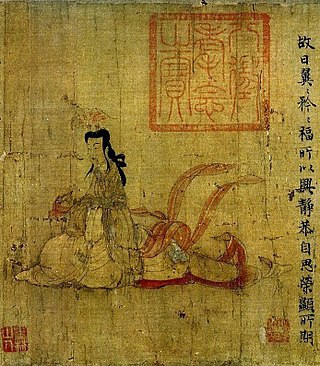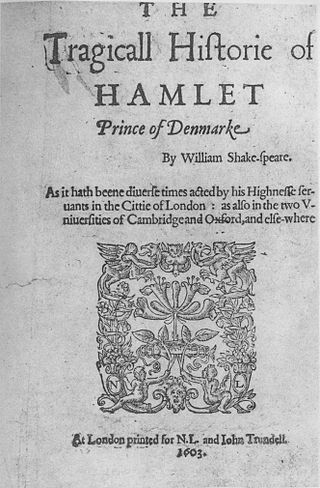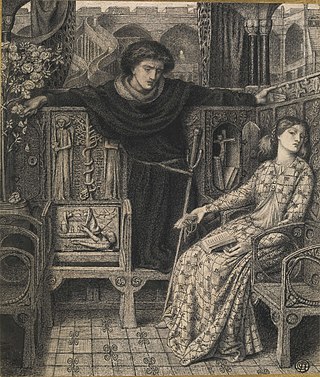Related Research Articles

The Tragedy of Hamlet, Prince of Denmark, often shortened to Hamlet, is a tragedy written by William Shakespeare sometime between 1599 and 1601. It is Shakespeare's longest play, with 29,551 words. Set in Denmark, the play depicts Prince Hamlet and his attempts to exact revenge against his uncle, Claudius, who has murdered Hamlet's father in order to seize his throne and marry Hamlet's mother. Hamlet is considered among the "most powerful and influential tragedies in the English language", with a story capable of "seemingly endless retelling and adaptation by others". It is widely considered one of the greatest plays of all time. Three different early versions of the play are extant: the First Quarto ; the Second Quarto ; and the First Folio. Each version includes lines and passages missing from the others.

The earliest texts of William Shakespeare's works were published during the 16th and 17th centuries in quarto or folio format. Folios are large, tall volumes; quartos are smaller, roughly half the size. The publications of the latter are usually abbreviated to Q1, Q2, etc., where the letter stands for "quarto" and the number for the first, second, or third edition published.

Richard III is a play by William Shakespeare. It was probably written c. 1592–1594. It is labelled a history in the First Folio, and is usually considered one, but it is sometimes called a tragedy, as in the quarto edition. Richard III concludes Shakespeare's first tetralogy and depicts the Machiavellian rise to power and subsequent short reign of King Richard III of England.

Pericles, Prince of Tyre is a Jacobean play written at least in part by William Shakespeare and included in modern editions of his collected works despite questions over its authorship, as it was not included in the First Folio. It was published in 1609 as a quarto, was not included in Shakespeare's collections of works until the third folio, and the main inspiration for the play was Gower's Confessio Amantis. Various arguments support the theory that Shakespeare was the sole author of the play, notably in DelVecchio and Hammond's Cambridge edition of the play, but modern editors generally agree that Shakespeare was responsible for almost exactly half the play — 827 lines — the main portion after scene 9 that follows the story of Pericles and Marina. Modern textual studies suggest that the first two acts, 835 lines detailing the many voyages of Pericles, were written by a collaborator, who may well have been the victualler, panderer, dramatist and pamphleteer George Wilkins. Wilkins published The Painful Adventures of Pericles Prince of Tyre which is the prose version of the story, and drew from Lawrence Twines' The Pattern of Painful Adventures. Pericles was one of the seventeen plays that were in print during Shakespeare's life, and was reprinted 5 times between 1609 and 1635.

This article presents a possible chronological listing of the composition of the plays of William Shakespeare.

Mr. William Shakespeare's Comedies, Histories, & Tragedies is a collection of plays by William Shakespeare, commonly referred to by modern scholars as the First Folio, published in 1623, about seven years after Shakespeare's death. It is considered one of the most influential books ever published.

"To be, or not to be" is a soliloquy given by Prince Hamlet in the so-called "nunnery scene" of William Shakespeare's play Hamlet. The speech is named for the opening phrase, itself among the most widely known and quoted lines in modern English literature, and the speech has been referenced in many works of theatre, literature and music.

Self-reflection is the ability to witness and evaluate our own cognitive, emotional, and behavioural processes. In psychology, other terms used for this self-observation include 'reflective awareness', and 'reflective consciousness', which originate from the work of William James.

This article is a collection of quotations and other comments on English playwright William Shakespeare and his works.

Sejanus His Fall, a 1603 play by Ben Jonson, is a tragedy about Lucius Aelius Sejanus, the favourite of the Roman emperor Tiberius.

A bad quarto, in Shakespearean scholarship, is a quarto-sized printed edition of one of Shakespeare's plays that is considered to be unauthorised, and is theorised to have been pirated from a theatrical performance without permission by someone in the audience writing it down as it was spoken or, alternatively, written down later from memory by an actor or group of actors in the cast – the latter process has been termed "memorial reconstruction". Since the quarto derives from a performance, hence lacks a direct link to the author's original manuscript, the text would be expected to be "bad", i.e. to contain corruptions, abridgements and paraphrasings.
William Shakespeare's play Hamlet has contributed many phrases to common English, from the famous "To be, or not to be" to a few less known, but still in everyday English.

From its premiere at the turn of the 17th century, Hamlet has remained Shakespeare's best-known, most-imitated, and most-analyzed play. The character of Hamlet played a critical role in Sigmund Freud's explanation of the Oedipus complex. Even within the narrower field of literature, the play's influence has been strong. As Foakes writes, "No other character's name in Shakespeare's plays, and few in literature, have come to embody an attitude to life ... and been converted into a noun in this way."
What follows is an overview of the main characters in William Shakespeare's Hamlet, followed by a list and summary of the minor characters from the play. Three different early versions of the play survive: known as the First Quarto ("Q1"), Second Quarto ("Q2"), and First Folio ("F1"), each has lines—and even scenes—missing in the others, and some character names vary.

Memorial reconstruction is the hypothesis that the scripts of some 17th century plays were written down from memory by actors who had played parts in them, and that those transcriptions were published. The theory is suggested as an explanation for the so-called "bad quarto" versions of plays, in which the texts differ dramatically from later published versions, or appear to be corrupted or confused.

William Shakespeare's Hamlet is a tragedy, believed to have been written between 1599 and 1601. It tells the story of Hamlet, Prince of Denmark—who takes revenge on the current king for killing the previous king and for marrying his father's widow —and it charts the course of his real or feigned madness. Hamlet is the longest play—and Hamlet is the largest part—in the entire Shakespeare canon. Critics say that Hamlet "offers the greatest exhibition of Shakespeare's powers".
The Arden Shakespeare is a long-running series of scholarly editions of the works of William Shakespeare. It presents fully edited modern-spelling editions of the plays and poems, with lengthy introductions and full commentaries. There have been three distinct series of The Arden Shakespeare over the past century, with the third series commencing in 1995 and concluding in January 2020. Arden was the maiden name of Shakespeare's mother, Mary, but the primary reference of the enterprise's title is to the Forest of Arden, in which Shakespeare's As You Like It is set.

Q1 of Hamlet is a short early text of the Shakespearean play. The intended publication of the play is entered in the Stationers' Register in 1602 by James Roberts, but Q1 was not published until summer or autumn 1603. It was published by the booksellers Nicholas Ling and John Trundell, and printed by Valentine Simmes. Roberts later printed the "Second Quarto" (Q2).

What a Piece of Work is a 1999 verse novel by Australian poet Dorothy Porter which was shortlisted for the 2000 Miles Franklin Award.

The Star Trek franchise, begun in 1966, has frequently included stories inspired by and alluding to the works of William Shakespeare. The science fiction franchise includes television series, films, comic books, novels and games, and has material both Star Trek canon and non-canon. Many of the actors involved have been part of Shakespearean productions, including Patrick Stewart and Christopher Plummer.
References
- ↑ Shakespeare, William. The Globe illustrated Shakespeare. The complete works, annotated, Deluxe Edition, (1986). Hamlet, Act II, scene 2, page 1879. Greenwich House, Inc. a division of Arlington House, Inc. distributed by Crown Publishers, Inc., 225 Park Avenue South, New York, NY 10003, USA.
- ↑ The First Edition of the Tragedy of Hamlet: London, 1603, p. 37. Nicholas Ling & J. Trundell, 1603. Reprinted by The Shakespeare Press, 1825.
- ↑ "Hamlet (1623 First Folio edition)". Archived from the original on October 18, 2013. Retrieved 2017-09-14.
{{cite web}}: CS1 maint: bot: original URL status unknown (link) - ↑ The New Shakespeare: Hamlet. Cambridge University Press, 1968.
- ↑ Knowles, Ronald. "Hamlet and Counter-Humanism." Renaissance Quarterly 52.4 (1999): 1046-69.